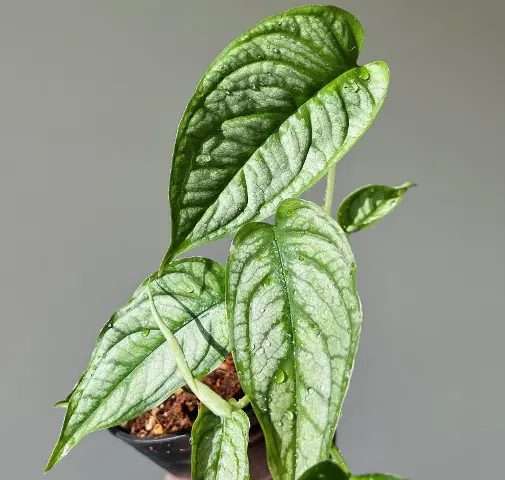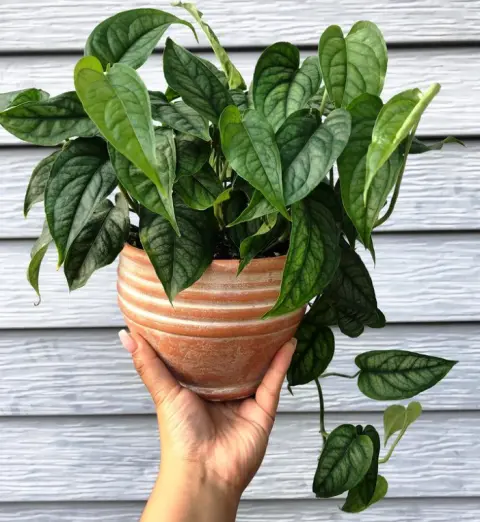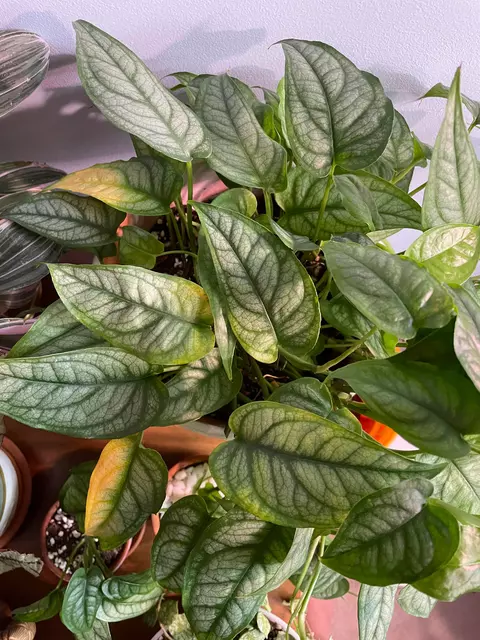The Monstera Siltepecana, native to Southern Mexico, is a captivating houseplant cherished for its unique beauty and ease of care. This tropical gem, commonly known as the “El Salvador Philodendron” boasts distinctive silver-striped leaves that resemble delicate works of art. Its foliage features intricate patterns, characterized by silvery-white veins against a rich green backdrop, adding a touch of elegance to any indoor space.
This houseplant thrives in indirect light and requires minimal maintenance, making it an ideal choice for both novice and experienced plant enthusiasts. Its vining nature allows it to cascade gracefully from hanging baskets or climb trellises, enhancing the aesthetics of any room. The Monstera Siltepecana El Salvador is not only a testament to nature’s artistry but also a testament to the joy of bringing a piece of the tropics into your home.
Monstera Siltepecana vs. El Salvador (Key Differences)


Monstera siltepecana el salvador Propagation
Propagating this beauty is a rewarding endeavor for plant enthusiasts, allowing you to share its elegance or expand your collection. There are several methods to propagate Monstera siltepecana, each with its unique advantages:
- Stem Cuttings: This is the most common and straightforward method. Simply take a healthy stem cutting with at least one node, which is the point where leaves and roots emerge. Place the cutting in a glass of water or directly in a well-draining potting mix. Keep it in a warm, indirect light location and change the water regularly if using the water propagation method. Once roots form, typically in a few weeks, transplant it into a pot.
- Air Layering: This method is suitable for more mature Monstera siltepecana plants. Select a section of the stem, make a small incision, and wrap it with moist sphagnum moss or a similar medium. Cover it with plastic wrap to maintain humidity. After roots have developed, usually in a few months, cut below the air layer and plant it separately.
- Offsets: Sometimes, Monstera siltepecana produces offsets or baby plants at the base of the main stem. Carefully separate these offsets and plant them in their pots or share them with fellow plant enthusiasts.
- Leaf Cuttings: While less common, you can propagate Monstera siltepecana from individual leaf cuttings. Cut a healthy leaf into sections with a vein running through them and plant them in a well-draining mix. Rooting may take longer compared to stem cuttings, but it’s possible.
Remember to provide a warm and humid environment during propagation, such as by using a plastic bag or a mini greenhouse. Once the new plants establish roots and begin to grow, treat them like mature Monstera siltepecana specimens, providing bright, indirect light and regular watering.
Monstera Siltepecana El Salvador Care
Caring for Monstera Siltepecana El Salvador involves providing the right conditions to allow its unique beauty to thrive. Here are essential care guidelines to help you cultivate a healthy and vibrant Monstera Siltepecana El Salvador:
- Light: These plants flourish in bright, indirect light. Avoid direct sunlight, which can scorch their leaves. Place them near a window with filtered or dappled sunlight, or use sheer curtains to diffuse the light. Inadequate light can lead to leggy growth with fewer leaves.
- Temperature: Monstera Siltepecana El Salvador prefers temperatures between 65-75°F (18-24°C) during the day and should not drop below 50°F (10°C) at night. Protect them from drafts and temperature extremes.
- Humidity: Being native to tropical regions, these plants thrive in high humidity. You can increase humidity by misting the leaves regularly, using a humidity tray, or placing a humidifier nearby. This helps prevent leaf browning and encourages healthy growth.
- Watering: Water your Monstera Siltepecana El Salvador when the top inch of soil feels dry to the touch. It’s important not to overwater, as they are susceptible to root rot. Ensure that your pot has good drainage to avoid waterlogged soil.
- Soil: Use a well-draining potting mix that retains some moisture but doesn’t stay soggy. A mix of peat moss, perlite, and orchid bark works well. Repot your plant when it outgrows its container, typically every couple of years.
- Fertilization: During the growing season (spring and summer), feed your Monstera Siltepecana El Salvador with a balanced liquid fertilizer every 4-6 weeks. Reduce or eliminate fertilization during the dormant winter months.
- Pruning: Regularly prune your plant to maintain its shape and encourage bushier growth. Trim any leggy or yellowing stems and remove dead or damaged leaves.
- Support: As they grow, Monstera Siltepecana El Salvador can become vining. Provide support such as stakes or a trellis to help guide their growth and prevent them from becoming too sprawling.
- Pests: Keep an eye out for common houseplant pests like spider mites and mealybugs. If you notice any, promptly treat your plant with neem oil or insecticidal soap.
With these care guidelines, you can enjoy the beauty of Monstera Siltepecana El Salvador in your home while helping it thrive and grow into a stunning addition to your indoor garden.
Monstera Siltepecana El Salvador leaves turning yellow

When Monstera Siltepecana El Salvador leaves start turning yellow, it’s a sign that the plant might be facing some issues that require attention. Here are a few common reasons and remedies for this problem:
- Overwatering: Yellowing leaves can be a result of overwatering, causing root rot. Ensure that the soil is allowed to dry slightly between watering. Adjust your watering schedule and consider repotting if the root system is affected.
- Underwatering: On the flip side, underwatering can also lead to yellowing leaves. Make sure you’re providing adequate moisture when the top inch of the soil feels dry to the touch.
- Poor Drainage: Inadequate drainage can lead to waterlogged soil, which can damage the roots and cause yellowing leaves. Ensure your pot has drainage holes and use a well-draining soil mix.
- Light Issues: Monstera Siltepecana El Salvador prefers bright, indirect light. If it’s placed in too much shade or direct sunlight, it can stress the plant, leading to yellowing leaves. Adjust its lighting conditions accordingly.
- Nutrient Deficiency: A lack of essential nutrients, particularly nitrogen, can result in yellowing leaves. Feed your plant with a balanced fertilizer during the growing season.
- Pests or Diseases: Inspect your plant for pests like spider mites or mealybugs, as well as any signs of fungal or bacterial diseases. Treat the issue promptly with appropriate remedies.
Regularly assess your Monstera Siltepecana El Salvador’s care routine and environment to address these potential causes of yellowing leaves. By identifying and addressing the underlying issue, you can help your plant recover and maintain its vibrant, green foliage.
MORE POSTS:
